A Study on the Dynamic Behavior of a Sieve in an Industrial Sifter
Abstract
:1. Introduction
2. Multi-Frequency Vibrating Screens
2.1. Linear-Elliptical Double-Frequency Sifter
2.2. Prototype Double-Frequency Sifter
- The inclination of the riddle in respect to the horizontal.
- Positioning the motors in respect to the center of the riddle.
- The excitation forces induced by the engines.
- Engine rotational speeds.
3. Materials and Methods
3.1. The Physical Model of the Two-Frequency Screen Used for Simulation
- The distance corresponding to position 4 and limited by maximum left distance corresponding to position 5.
- The distance corresponding to position 3 been limited by the maximum right distance corresponding to position 6.
3.2. Determination of Equations of Motion
3.3. The Research Stand
- (a)
- Maximal stimulating force—2 N.
- (b)
- ½ of maximal stimulating force.
- (c)
- ¼ of maximal stimulating force.
- = 1500 rpm.
- 2/3 = 1000 rpm.
- 1/2 = 750 rpm.
- 1/3 = 500 rpm.
3.3.1. Measurement
3.3.2. Parameter for Comparison of Results from Measurement and Simulation
4. Results and Discussion
4.1. Screen Trajectories Resulted from Simulation
4.2. Results from Measurements
4.3. Comparison of Results from Measurement and Simulation
5. Conclusions
- The multiple of the ratio value equal to 1/3 was beneficial as it increased the complexity of sieve traffic paths, translating into better sieving intensity and better mixing of the material on the sieves.
- The reverse synchronization can allow the more intensive motion of the screen center than in the case of the compatible synchronization, resulting in better mixing of the screened material, especially in the middle part of the screen.
- Given the local deformations of the screen frame, the mechanical damping occurring in the real screen, and the characteristics of the measurement paths, introducing time delays for signals measured by sensors can affect the shape complexity of the traffic paths of the screen center.
- The obtained measurement values of the ratio, being proportional to the motion intensity of the observed sieve point, were 1.5–2.2-fold higher for the compatible synchronization and 1.1–2.4-fold higher for the reverse one, respectively, compared to those obtained from simulation.
- For the reverse synchronization, the values of the ratio obtained from the measurement were slightly higher than those obtained for compatible synchronization.
- Future research directions may include the influence of changes in materials and geometrical parameters of the screen components on the obtained frequencies and forms of its natural vibrations and the changes in the control algorithm of devices forcing the vibrations of the screen dictated by them. In addition, more complex mathematical models of the sieve can be developed, considering either its discretization to the form of many rigid elements or treating it as a continuous flexible object. Typically, the use of such more complex models leads to the involvement of more computing power in numerical analyses.
Author Contributions
Funding
Institutional Review Board Statement
Informed Consent Statement
Data Availability Statement
Conflicts of Interest
References
- Gursky, V.; Kuzio, I.; Krot, P.; Zimroz, R. Energy-Saving Inertial Drive for Dual-Frequency Excitation of Vibrating Machines. Energies 2021, 14, 71. [Google Scholar] [CrossRef]
- Kumar, D.; Kumar, D. Chapter 4—Coal Sizing. In Sustainable Management of Coal Preparation; Kumar, D., Kumar, D., Eds.; Woodhead Publishing: Walnut St Philadelphia, PA, USA, 2018; pp. 49–68. [Google Scholar] [CrossRef]
- Wills, B.A.; Finch, J.A. Chapter 8—Industrial Screening. In Wills’ Mineral Processing Technology, 8th ed.; Wills, B.A., Finch, J.A., Eds.; Butterworth-Heinemann: Oxford, UK, 2016; pp. 181–197. [Google Scholar] [CrossRef]
- Simonyan, K.J.; Yiljep, Y. Investigating grain separation and cleaning efficiency distribution of a conventional stationary rasp-bar sorghum thresher. Agric. Eng. Int. CIGR Ej. 2008, 10, 1–10. [Google Scholar]
- Aipov, R.; Linenko, A.; Badretdinov, I.; Tuktarov, M.; Akchurin, S. Research of the work of the sieve mill of a grain-cleaning machine with a linear asynchronous drive. Math. Biosci. Eng. 2020, 17, 4348–4363. [Google Scholar] [CrossRef]
- Giyevskiy, A.M.; Orobinsky, V.I.; Tarasenko, A.P.; Chernyshov, A.V.; Kurilov, D.O. Substantiation of basic scheme of grain cleaning machine for preparation of agricultural crops seeds. IOP Conf. Ser. Mater. Sci. Eng. 2018, 327, 042035. [Google Scholar] [CrossRef]
- Savinyh, P.; Sychugov, Y.; Kazakov, V.; Ivanovs, S. Development and theoretical studies of grain cleaning machine for fractional technology of flattening forage grain. In Proceedings of the 17th International Scientific Conference Engineering for Rural Development Engineering for Rural Development, Jelgava, Latvia, 23–25 May 2018; pp. 124–130. [Google Scholar]
- Vasylkovskyi, O.; Vasylkovska, K.; Moroz, S.; Sviren, M.; Storozhyk, L. The influence of basic parameters of separating conveyor operation on grain cleaning quality. INMATEH 2019, 57, 63–70. [Google Scholar] [CrossRef]
- Steponavičius, D.; Špokas, L.; Petkevičius, S. The influence of position of the first straw walkers section on grain separation. Agron. Res. 2008, 6, 377–385. [Google Scholar]
- Ma, L.; Song, X.; Wang, H.; Xu, X.; Han, T.; Guo, H. Screening Kinematics Analysis of Cleaning Organs, and Extractives. IOP Conf. Ser. Mater. Sci. Eng. 2018, 452, 042123. [Google Scholar] [CrossRef]
- Popov, I.P.; Chumakov, V.G.; Terentyev, A.D. Drive power reduction of sieve sorting machines. In Scientific and Technical Statements of St. Petersburg State Polytechnic University; St. Petersburg State Polytechnic University: St. Petersburg, Russia, 2015; Volume 2, pp. 175–181. [Google Scholar]
- Shevtsov, I.V.; Beznosov, V.A. Drive unit for sieve mills of grain cleaning machines. Agrar. Vestn. Ural. 2014, 2, 43–45. [Google Scholar]
- Aradwad, P.P.; Sinha, J.P.; Kumar, T.V.A.; Yadav, R.S.; Samuel, D.V.K. Development of solar powered screen cleaner. Indian J. Agric. Sci. 2018, 88, 1914–1919. [Google Scholar]
- Vyngra, A.V.; Avdeyev, B.A.; Abdurakhmanov, R.F.; Yenivatov, V.V.; Ovcharenko, I.K. Mathematical model of start for a piston compressor electric drive of a ship refrigerator. In Proceedings of the 2019 IEEE Conference of Russian Young Researchers in Electrical and Electronic Engineering, ElConRus, St. Petersburg, Russia, 28–31 January 2019; pp. 373–376. [Google Scholar]
- Yarullin, R.; Aipov, R.; Gabitov, I.; Linenko, A.; Akchurin, S.; Mudarisov, S.; Khasanov, E.; Rakhimov, Z.; Masalimov, I. Adjustable driver of grain cleaning vibro-machine with vertical axis of eccentric masses rotation. J. Eng. Appl. Sci. 2018, 13, 6398–6406. [Google Scholar] [CrossRef]
- Linenko, A.V.; Gabitov, I.I.; Baynazarov, V.G.; Tuktarov, M.F.; Aipov, R.S.; Akchurin, S.V.; Kamalov, T.I.; Badretdinov, I.D.; Leontiev, D.S.; Vokhmin, V.S. The mechatronic module “linear electric drive—sieve boot” intelligent control system of grain cleaner. J. Balk. Tribol. Assoc. 2019, 25, 708–717. [Google Scholar]
- Chen, L.; Li, D.; Zhao, J. Control of a linear reciprocating switched reluctance motor for compressors. In Proceedings of the 14th IEEE Conference on Industrial Electronics and Applications, ICIEA, Xi’an, China, 19–21 June 2019; pp. 2003–2008. [Google Scholar]
- Neyman, L.A.; Neyman, V.Y. Dynamic model of a vibratory electromechanical system with spring linkage. In Proceedings of the 2016 11th International Forum on Strategic Technology, IFOST, Novosibirsk, Russia, 1–3 June 2016; pp. 23–27. [Google Scholar]
- Solomin, A.V.; Chekhova, A.A. Magnetic field and current displacement in groove of secondary element of adjustable linear induction motor. In Proceedings of the 2019 International Ural Conference on Electrical Power Engineering, UralCon, Chelyabinsk, Russia, 1–3 October 2019; pp. 271–276. [Google Scholar]
- Luoyang Haiside Heavy Industry Co., Ltd. What Are the Reasons for the Mixing of the Linear Vibrating Screen? Causes and Solutions. 2021. Available online: https://www.hsd-industry.com/news/reasons-for-mixing-of-linear-vibrating-screen/ (accessed on 17 August 2022).
- Szymanski, T.; Wodzinski, P. Characteristics of Screening in Screens with Vibrating Sieves. Physicochem. Probl. Miner. Process. 2005, 39, 177–188. [Google Scholar]
- Lawinska, K.; Modrzewski, R. Analysis of sieve holes blocking in a vibrating screen and a rotary and drum screen. Physicochem. Probl. Miner. Process. 2017, 53, 812–828. [Google Scholar]
- Li, H.; Li, Y.; Guo, F.; Zhao, Z.; Xu, L. CFD–DEM simulation of material motion in air-and-screen cleaning device. Comput. Electron. Agric. 2012, 88, 111–119. [Google Scholar] [CrossRef]
- Li, H.; Li, Y.; Tang, Z.; Xu, L.; Zhao, Z. Numerical simulation and analysis of vibration screening based on EDEM. Trans. CSAE 2011, 27, 117–121. [Google Scholar] [CrossRef]
- Elskamp, F.; Kruggel-Emden, H. DEM simulations of screening processes under the influence of moisture. Chem. Eng. Res. Des. 2018, 136, 593–609. [Google Scholar] [CrossRef]
- Elskamp, F.; Kruggel-Emden, H. Extension of process models to predict batch screening results under the influence of moisture based on DEM simulations. Powder Technol. 2019, 342, 698–713. [Google Scholar] [CrossRef]
- Yan, H.; Li, Y.; Yuan, F.; Peng, F.; Yang, X.; Hou, X. Analysis of the Screening Accuracy of a Linear Vibrating Screen with a Multi-layer Screen Mesh. Stroj. Vestn. J. Mech. Eng. 2020, 66, 289–299. [Google Scholar] [CrossRef]
- Sullivan, J.F. Screening Theory and Practice; Triple/S Dynamics: Dallas, TX, USA, 2012. [Google Scholar]
- Gursky, V.; Krot, P.; Korendiy, V.; Zimroz, R. Dynamic Analysis of an Enhanced Multi-Frequency Inertial Exciter for Industrial Vibrating Machines. Machines 2022, 10, 130. [Google Scholar] [CrossRef]
- Moncada, M.M.; Rodriguez, C.G. Dynamic Modeling of a Vibrating Screen Considering the Ore Inertia and Force of the Ore over the Screen Calculated with Discrete Element Method. Shock Vib. 2018, 2018, 1714738. [Google Scholar] [CrossRef]
- Sidor, J. A Mechanical Layered Model of a Vibratory Mill. Mech. Control 2010, 29, 138–148. [Google Scholar]
- Tomach, P. An attempt to increase technological capabilities of laboratory vibratory mills by changing the construction of chamber. New Trends Prod. Eng. 2019, 2, 195–205. [Google Scholar] [CrossRef]
- Feliks, J.; Krawczyk, M. Modeling the movement of broadcast on the concentration table. New Trends Prod. Eng. 2019, 2, 304–311. [Google Scholar] [CrossRef]
- Feliks, J.; Mitura, A.; Marciniak−Kowalska, J. Analysis of possibilities of application of vibratory cluster−producing device to alternative fuel production. Pol. J. Environ. Stud. 2013, 22, 12–17. [Google Scholar]
- Neikov, O.D. Chapter 2—Mechanical Crushing and Grinding. In Handbook of Non-Ferrous Metal Powders; Neikov, O.D., Naboychenko, S.S., Murashova, I.V., Gopienko, V.G., Frishberg, I.V., Lotsko, D.V., Eds.; Elsevier: Amsterdam, The Netherlands, 2009; pp. 47–62. [Google Scholar] [CrossRef]
- Peng, L.; Feng, H.; Wang, Z.; Wang, H.; Yang, H.; Huang, H. Screening Mechanism and Properties of a Cantilevered Vibrating Sieve for Particles Processing. Appl. Sci. 2019, 9, 4911. [Google Scholar] [CrossRef]
- Liu, Y.; Meng, G.; Suo, S.; Li, D.; Wang, A.; Cheng, X.; Yang, J. Spring Failure Analysis of Mining Vibrating Screens: Numerical and Experimental Studies. Appl. Sci. 2019, 9, 3224. [Google Scholar] [CrossRef] [Green Version]
- Lanczos, C. The Variational Principles of Mechanics. Dover Books on Physics; Dover Publications: Mineola, NY, USA, 2012; p. 464. [Google Scholar]
- Nguyen, V.X.; Golikov, N.S. Analysis of material particle motion and optimizing parameters of vibration of two-mass GZS vibratory feeder. IOP Conf. Ser. J. Phys. 2018, 1015, 052020. [Google Scholar] [CrossRef]





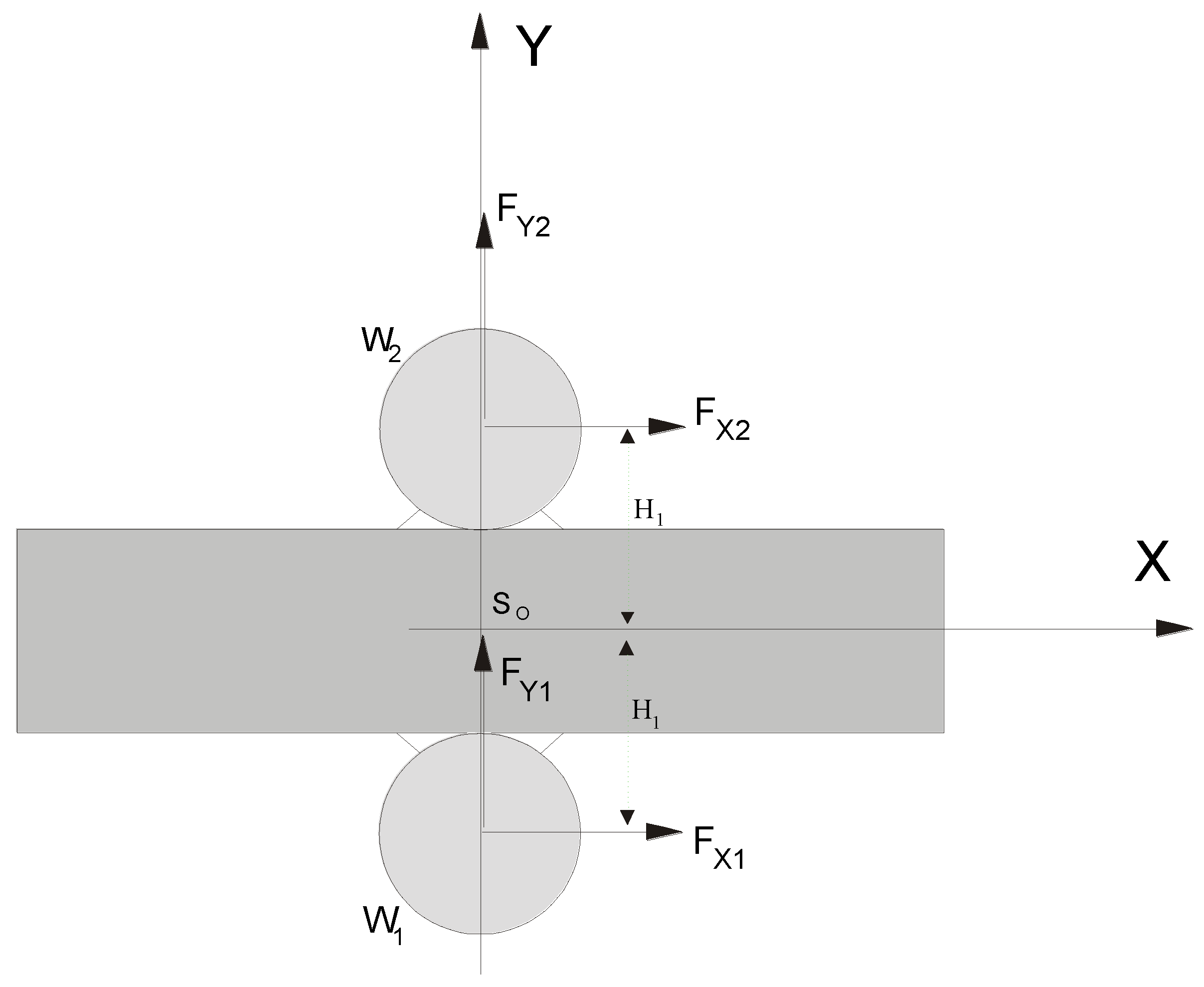

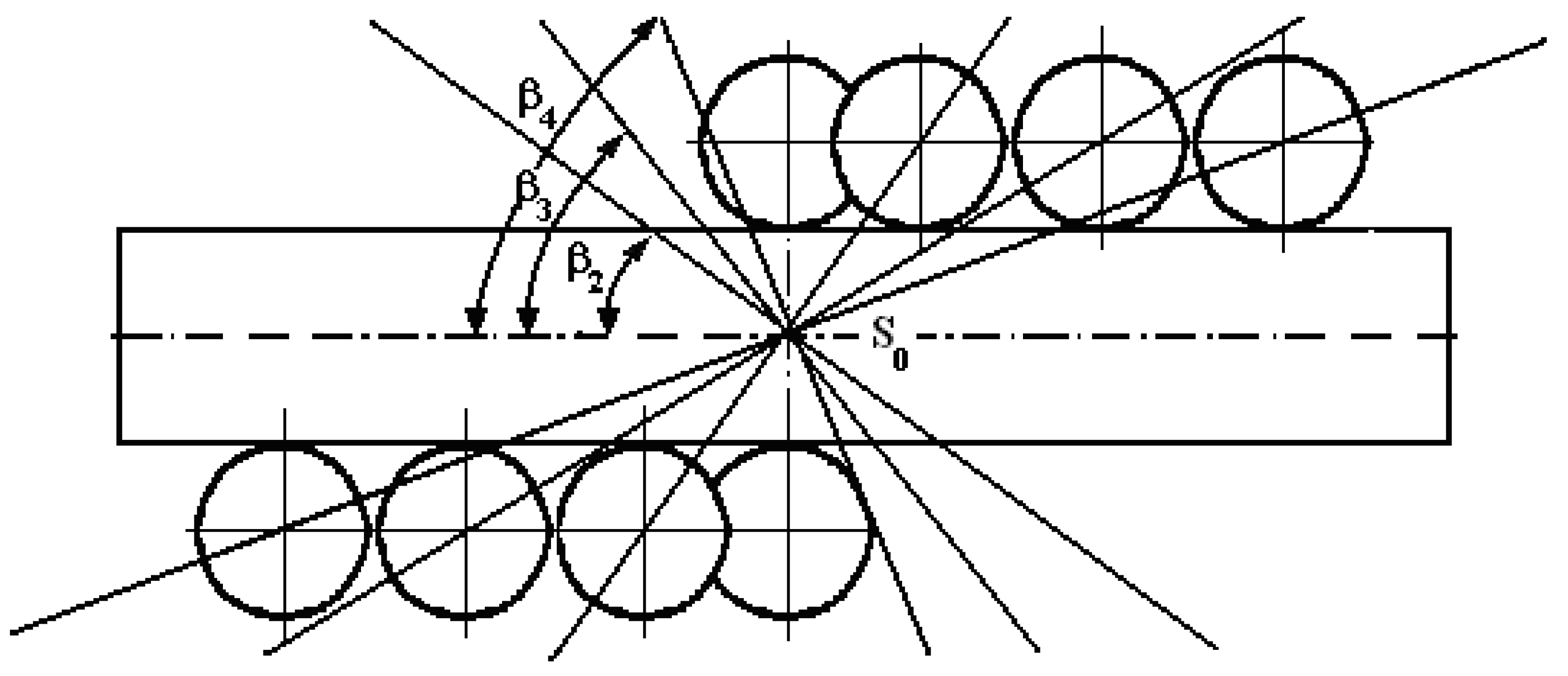
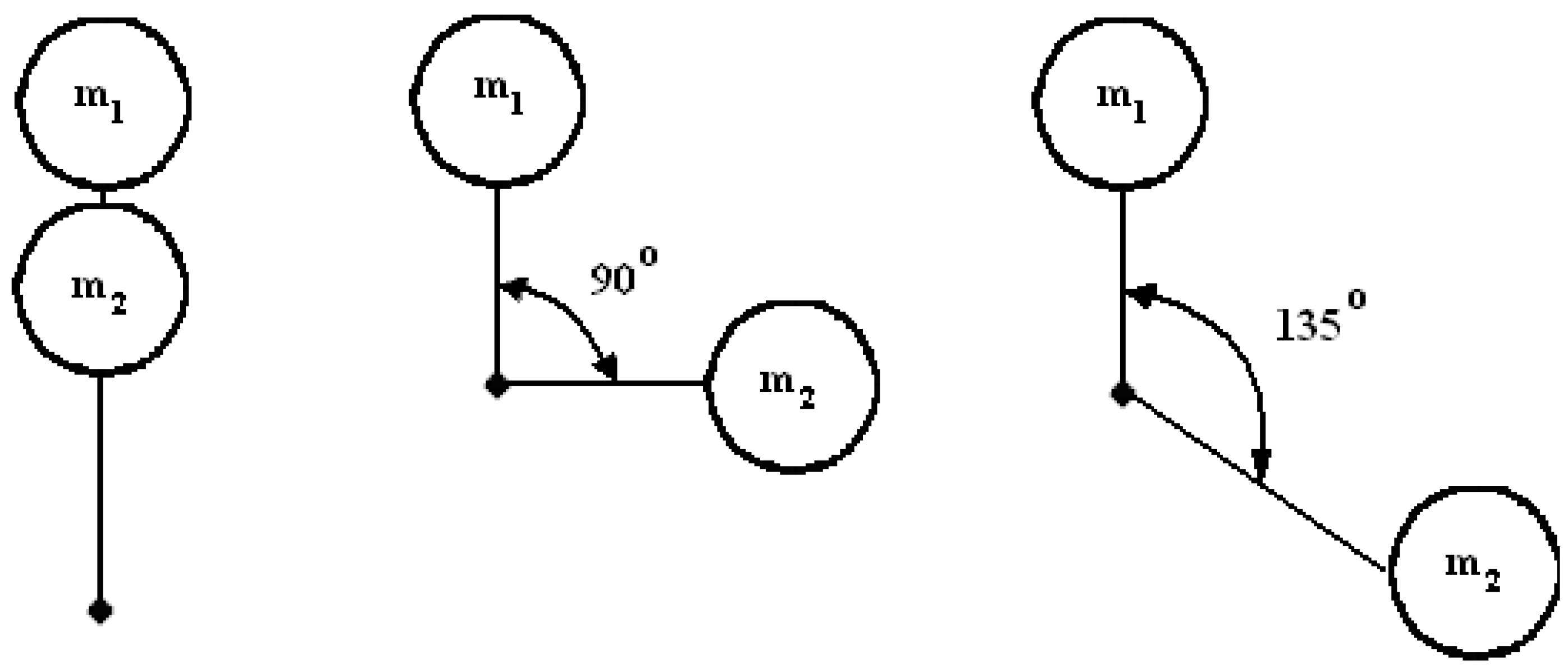
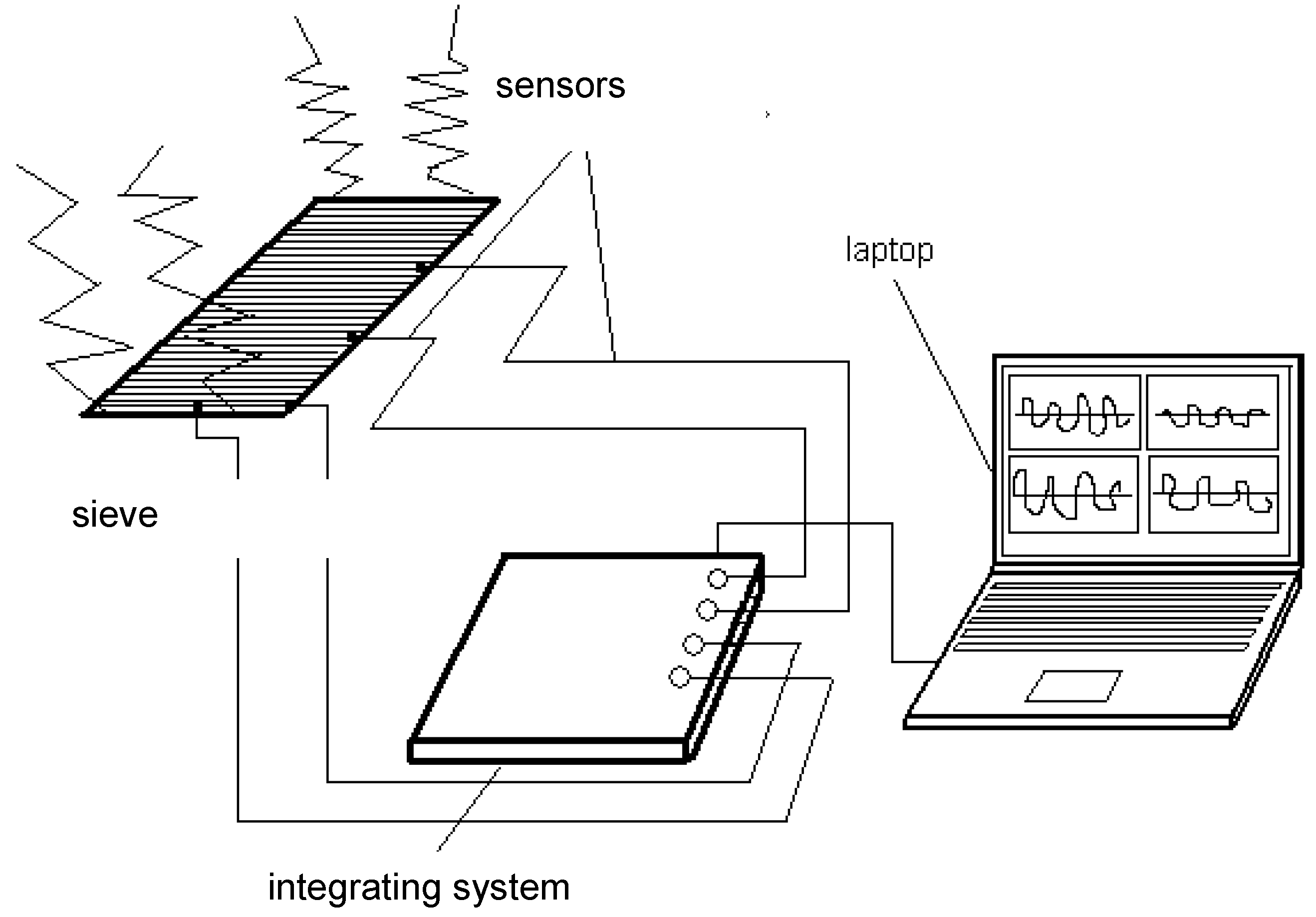

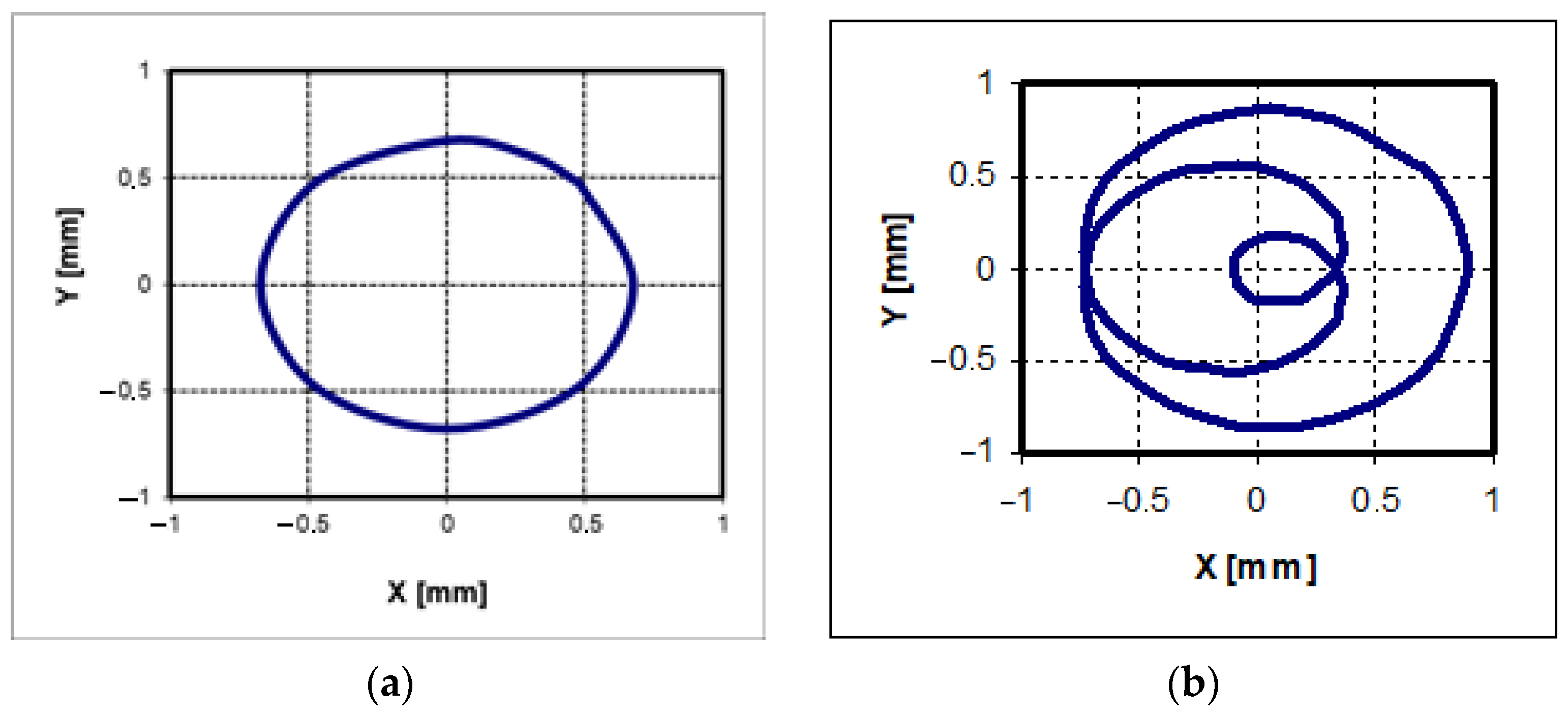



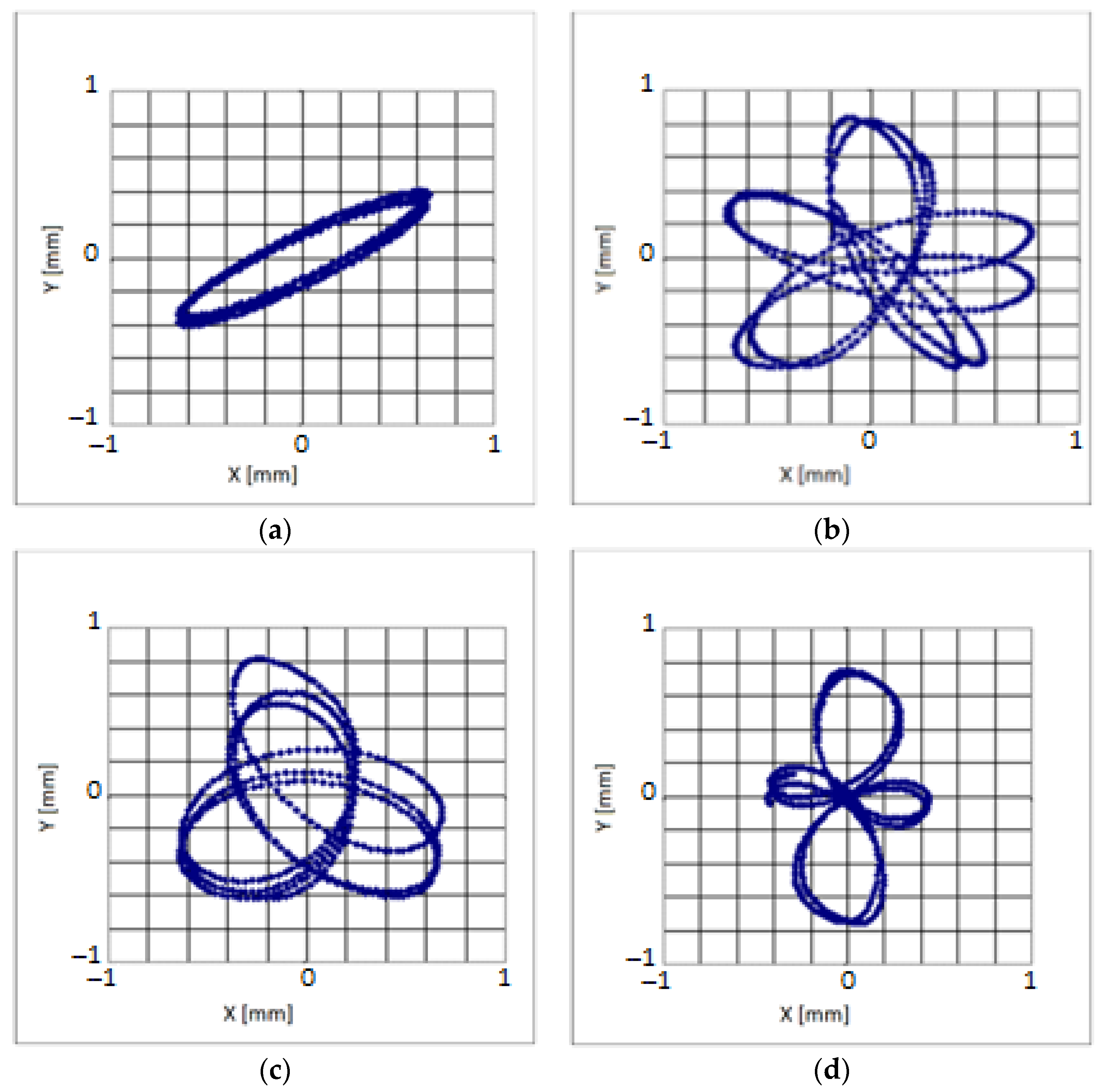
| Synchronization | Compatible | Reverse | ||
|---|---|---|---|---|
| Simulation | Measurement | Simulation | Measurement | |
| 1 | 0.081 | 0.176 | 0.175 | 0.180 |
| 2/3 | 0.155 | 0.232 | 0.101 | 0.238 |
| ½ | 0.157 | 0.229 | 0.105 | 0.226 |
| 1/3 | 0.155 | 0.253 | 0.127 | 0.259 |
Publisher’s Note: MDPI stays neutral with regard to jurisdictional claims in published maps and institutional affiliations. |
© 2022 by the authors. Licensee MDPI, Basel, Switzerland. This article is an open access article distributed under the terms and conditions of the Creative Commons Attribution (CC BY) license (https://creativecommons.org/licenses/by/4.0/).
Share and Cite
Modrzewski, R.; Obraniak, A.; Rylski, A.; Siczek, K. A Study on the Dynamic Behavior of a Sieve in an Industrial Sifter. Appl. Sci. 2022, 12, 8590. https://doi.org/10.3390/app12178590
Modrzewski R, Obraniak A, Rylski A, Siczek K. A Study on the Dynamic Behavior of a Sieve in an Industrial Sifter. Applied Sciences. 2022; 12(17):8590. https://doi.org/10.3390/app12178590
Chicago/Turabian StyleModrzewski, Remigiusz, Andrzej Obraniak, Adam Rylski, and Krzysztof Siczek. 2022. "A Study on the Dynamic Behavior of a Sieve in an Industrial Sifter" Applied Sciences 12, no. 17: 8590. https://doi.org/10.3390/app12178590






